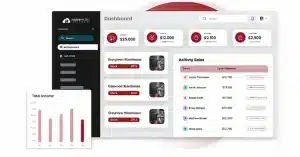An organized warehouse layout is important to ensure that the stock in the warehouse can be stored properly. However, you yourself must also understand that organizing goods in the warehouse is not an easy thing, especially if done manually.
Managing goods manually will be prone to errors, one of which is difficulty tracking goods. This can happen because manual arrangement does not use a fixed storage location system, so the warehouse team must check one by one if they want to find the item. Of course, you don’t want this to happen, right? In this case, the warehouse racking system plays a role.
Warehouse racking system is a storage system specifically designed to help companies organize goods in the warehouse efficiently. This system utilizes special shelves to arrange goods vertically, so as to optimize storage space and facilitate the process of retrieving goods.
Sa artikulong ito, tatalakayin natin ang mga sistema ng racking ng warehouse, ang kanilang mga uri, at kung paano gumagana ang mga ito. Panatilihin ang pagbabasa upang makakuha ng higit pang impormasyon!

Table of Content
Content Lists
Key Takeaways
|
What is a Warehouse Racking System?
Warehouse racking system is a storage system in a warehouse that uses special shelves to arrange and organize goods vertically. This system is designed to maximize the use of space in the warehouse by utilizing the height of the room, so as to optimally utilize the warehouse capacity.
This system helps organize goods in a neat and structured manner, making the process of placing and retrieving goods easier and faster. Each shelf is usually labeled and location coded which makes it easier for warehouse workers to track and locate items efficiently. In addition, racking system warehouse also minimizes the risk of damage to goods because each item is stored in a safe and organized manner.
The use of a warehouse racking system also supports more accurate inventory management. With structured storage, stock data can be updated in real-time using a warehouse management system (WMS). This allows management to conduct precise stock monitoring and reduce the risk of shortages or overstocks.
Types of Warehouse Racking
After understanding the definition of a racking warehouse system, we will dive deeper into the types of warehouse racking. Here are the types of warehouse racking:
Selective racking
This type of Warehouse racking is the most common and flexible, allowing direct access to every pallet in the rack. Selective racking is ideal for warehouses with various types of products and high rotation of goods, as it eases the process of picking and placing goods.
However, the disadvantage of this system is the less-than-optimal space efficiency as it requires many aisles between racks.
Drive-in racking
This warehouse racking is designed for the storage of large quantities of goods of a similar type. Drive-in racking allows forklifts to enter into the rack and place or retrieve items. This system is more space-saving as it minimizes the number of aisles.
However, access to goods is limited as it uses the Last In, First Out (LIFO) principle, making it suitable for products that do not require rapid stock rotation.
Push back racking
This type uses a rail and trolley system to store multiple pallets horizontally in one aisle. When a new pallet is inserted, the previous pallet will be pushed back. When the front pallet is retrieved, the pallet behind it will automatically move forward.
Push back racking optimizes space usage and offers easier access than drive-in racking, while still using the LIFO principle.
Pallet flow racking
This rack uses a gravity system with rollers or conveyors to move pallets automatically from the back to the front of the rack. Pallets are inserted from one side and retrieved from the other, thus following the First In, First Out (FIFO) principle. Pallet flow racking is suitable for products with a sensitive shelf life and requires fast stock rotation.
Cantilever Racking
This type of rack is specifically designed to store long or irregularly shaped items, such as wood, pipes, or metal. Cantilever racks have long arms that attach to the main posts, allowing for easy access and placement of items of various sizes. It is ideal for warehouses that store construction materials or bulky items
Things That Need to Be Considered to Choose the Right Type of Warehouse Racking
Determining the appropriate warehouse racking requires several important considerations to ensure storage efficiency and smooth warehouse operations. Here are the things that need to be considered:
Type and size of goods
Choose racking based on the type, size, and weight of the goods to be stored. For example, long items such as pipes or lumber are better suited for cantilever racking, while heavy items stored on pallets are better suited for selective or drive-in racking.
Understanding the characteristics of the goods will help determine the type of racking that can withstand the load and facilitate access.
Stock rotation (FIFO or LIFO)
If goods have a limited shelf life or require rapid stock rotation (FIFO), such as food or pharmaceutical products, choose racking, such as pallet flow racking. However, if stock rotation is not an issue, and products that are last in can be first out (LIFO), types such as drive-in or push back racking may be a more appropriate option.
Warehouse space capacity
Consider the area and height of the warehouse to determine the most efficient racking. If horizontal space is limited but there is sufficient height, using tall racking systems such as selective or pallet flow racking can maximize the use of vertical space. Also, consider the layout of the warehouse to optimize aisle access for forklift operations and other equipment.
Frequency of item access
If items need to be accessed frequently, choose racking that allows direct access to each item, such as selective racking. However, for items that are stored in bulk and do not require frequent access, drive-in or push back racking can be a more space-efficient option.
Budget and maintenance costs
Adjust the type of racking to your available budget, including installation and maintenance costs. Some racking, such as selective racking, has lower installation costs but may be less efficient in terms of space usage.
Meanwhile, systems such as pallet flow racking may require a larger investment, but offer long-term benefits in terms of efficiency and stock rotation.
Benefits of Implementing a Warehouse Racking System
We have discussed the definition of warehouse racking system and its types. However, what exactly are the benefits of implementing a racking system software?
The application of a warehouse racking system provides the main benefit of more optimal space utilization. By using storage shelves, goods can be arranged by utilizing the warehouse height to the maximum. This allows the warehouse to hold more goods without the need to expand the physical area of the warehouse.
Another benefit is increased efficiency in stock management. Warehouse racking systems allow goods to be organized by category, frequency of use, and date of entry, making the process of placing and retrieving goods faster and more precise.
Safety and reduced risk of damage to goods are also important benefits of this system. The shelves are designed to bear weight and keep goods in a stable condition, reducing the risk of goods falling or being damaged due to irregular stacking.
The benefits of implementing a racking system can also increase if you integrate it with warehouse management software. The use of warehouse management software helps you to monitor racking with one integrated system.
In addition, the warehouse management system also helps you get real-time reports. This keeps you updated on the amount of goods stored. One example of a warehouse storage system that you can use is HashMicro because this system is able to generate accurate real-time reports for you. Schedule a free demo now!
If you want to know some WMS recommendations, you can read our previous article that discusses the best warehouse management system.
Tips for Choosing a Warehouse Management System that Suits Your Business
Indeed, the implementation of a warehouse racking system can help you in managing goods in the warehouse to be more optimal. However, you still need to integrate with a warehouse management system to make it easier to monitor the activity of placing goods.
Unfortunately, not all warehouse management systems available out there can be suitable and run optimally to help you. Therefore, we will present some tips that can help you determine the warehouse management system that suits your business:
- Adjust to the scale of operations: Choose a software that suits the scale of your warehouse and racking system needs. Make sure the software can manage the number of vendors according to the size and complexity of warehouse operations, both for small and large warehouses.
- Inventory management features: Ensure that the software has advanced inventory management features, such as real-time stock tracking, automatic placement of items on the racking system, and stock level monitoring. This helps in ensuring efficient and optimized storage.
- Integration capabilities: Choose software that can be integrated with your warehouse management system (WMS) and racking system. This capability will ensure inventory data and item placement can be managed thoroughly and synchronously, optimizing warehouse performance.
- Ease of use: Choose software with an interface that is easy for the warehouse team to use. Users should be able to monitor and manage vendors and stock items on the racking system easily, without the need for complicated training.
- Flexibility and scalability: Make sure the software you choose can adapt to the changing needs of the warehouse. If your warehouse operations grow, the software should be able to accommodate the addition of racks, products, and vendors without disrupting the workflow.
Revolutionoze Your Warehouse Racking Process with HashMicro’s WMS

As a warehouse management system (WMS), the HashMicro system is equipped with a comprehensive range of features that can help various warehouse management needs, one of which is warehouse racking.
Not only that, HashMicro also provides extensive and varied customization options. So, you can be sure that this system can run optimally according to the various unique needs required by your business without missing a thing.
Furthermore, HashMicro also does not limit the number of users to use this application. This can allow management parties consisting of many people to run the application simultaneously. Thus, you can minimize the occurrence of fraud or theft of goods in the warehouse.
Here are some features of HashMicro’s WMS that can help you with your warehouse racking system:
- Product dimension tracking: This feature allows users to track product dimensions such as size, weight, and volume. With this feature, the system automatically calculates the space required for each item in the racking system to help ensure efficient arrangement of goods.
- Location dimension management: This feature allows for more detailed management of storage locations in the warehouse. The warehouse can be divided into various locations or zones, and each rack and storage slot can be labeled with specific dimensions.
- Warehouse pallet tracking: This feature enables real-time pallet tracking throughout the warehouse. Each pallet is given a unique identification so that the movement and location of pallets can be monitored easily. This feature is particularly useful in racking systems as it ensures that each pallet is in the correct location.
- Warehouse reporting: This feature provides complete reports on warehouse operations, including reports on stock, goods movement, space usage in the racking system, and operational performance. These reports assist management in analyzing storage efficiency, identifying problems, and making decisions based on accurate data.
- Push notifications: This feature provides automatic notifications to users regarding important activities in the warehouse, such as stock approaching the minimum limit, placement of new items, or pallet movement. With real-time notifications, warehouse staff and management can take the necessary actions immediately.
Conclusions
Warehouse racking is a storage system in a warehouse that uses special shelves to organize goods in a vertical and structured manner. With a racking system, warehouses can accommodate more goods without expanding the physical area, reduce the risk of damage to goods, and support more accurate inventory management.
To further facilitate the management of warehouse racking, integrating with HashMicro’s WMS can be an alternative solution that you can do. This system comes with a comprehensive range of features that can help you.
If you are curious about how this system works, register for a free demo now!
FAQ
-
What is the difference between storage and warehouse?
The difference between a storage and a warehouse lies in the area and quantity of goods that can be stored. A warehouse has a larger area and capacity and is commonly used by companies to store stock.
-
What is a racking bay?
Racking bays are storage systems consisting of strong structured racks used to efficiently hold goods in a warehouse or storage room.
-
What is a warehouse management system (WMS)?
Warehouse Management System (WMS) is software used to manage and control operational activities in the warehouse, such as receiving goods, storage, picking, and shipping.
{
“@context”: “https://schema.org”,
“@type”: “FAQPage”,
“mainEntity”: [{
“@type”: “Question”,
“name”: “What is the difference between storage and warehouse?”,
“acceptedAnswer”: {
“@type”: “Answer”,
“text”: “The difference between a storage and a warehouse lies in the area and quantity of goods that can be stored. A warehouse has a larger area and capacity and is commonly used by companies to store stock.”
}
},{
“@type”: “Question”,
“name”: “What is a racking bay?”,
“acceptedAnswer”: {
“@type”: “Answer”,
“text”: “Racking bays are storage systems consisting of strong structured racks used to efficiently hold goods in a warehouse or storage room.”
}
},{
“@type”: “Question”,
“name”: “What is a warehouse management system (WMS)?”,
“acceptedAnswer”: {
“@type”: “Answer”,
“text”: “Warehouse Management System (WMS) is software used to manage and control operational activities in the warehouse, such as receiving goods, storage, picking, and shipping.”
}
}]
}




































